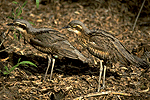Bush stone-curlew

Common name: bush stone-curlew or bush thick-knee
Scientific name: Burhinus grallarius
Family: Burhinidae (thick-knees)
Conservation status: This species is listed as Least Concern in Queensland (Nature Conservation Act 1992).
Description
The bush stone-curlew has long legs, knobbly 'knees' (actually ankles) and a small black bill. It has grey-brown feathers with black streaks, a white forehead and eyebrows, a broad, dark-brown eye stripe and golden eyes.
Habitat and distribution
Bush stone-curlews are found across most of Australia, living in open forests and woodlands, near watercourses or swamps. This shy species lives in pairs or loose flocks occupying a breeding territory of between 10-25 hectares.
Life history and behaviour
Unlike most birds, this species hides during the day and feeds at night, looking for seeds, insects, spiders and small frogs and reptiles. During the day it squats on the grass, either alone or in a small group. When threatened, it will stay still or walk slowly away.
The female bush stone-curlew usually lays 2 eggs in a nest on the ground where they are incubated for 28 days.
Listen
Listen for its loud, eerie wailing after dark.
† Requires an appropriate media player